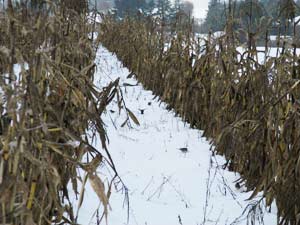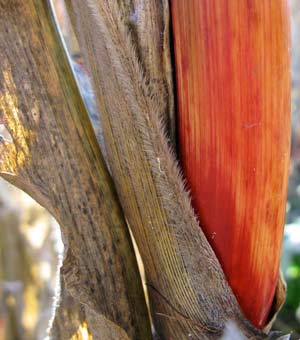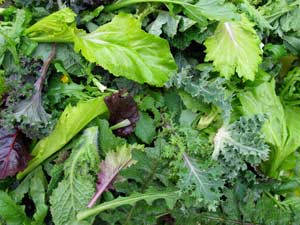Beautiful Corn: America’s Original Grain from Seed to Plate
[Beautiful Corn] “is a ‘how-to’ from planting to eating. I provide a practicum of corn growing from seed selection through seed production, based on my experience as a farmer and gardener. If a young person can take a beautiful ear of corn, pry off a few kernels, and grow some new ear’s in her family’s backyard, the process is hardly beyond the ken of most people. But there is more to appreciating corn than just dropping a seed into the ground”.
—Anthony Boutard, from the introduction to his new book.

Soon the Snow Flies-Chapter 16
A mechanically harvested field of grain is a source of winter sustenance for waterfowl along the migratory routes. It is a common sight to see thousands of ducks and geese across a field feeding on the spilled grain. In cornfields off of the flyways, turkeys and deer sate themselves. On a winter day, a raucous murder of crows will descend upon the cornfield, gleaning the last kernels from the decaying ears. Because we grow valuable food-grade corn on small plots, we are more parsimonious with our grain. There are not enough kernels among the culled ears to attract flocks of ducks and geese. Nonetheless, there is more life among the dead corn stalks than is visible at first glance.
Early in our career as farmers, we were anxious to put the farm to bed at the end of the season, just as we had always done with our backyard garden and community garden plot. That meant mowing down the vegetable remains, disking the field, and planting a cover crop to nourish the soil for the next season’s crop. In the spring, the lush green cover crop was mowed, allowed to dry, and then turned under. This reflexive act was based on the organic farmer’s creed that no patch of earth shall be left bare, combined with the compelling aesthetic of the fresh green cover crop. In our minds was an image of millions of microbes eagerly devouring the cover crop and creating the basis for a vital, energetic ecosystem within the soil matrix. Sure, it was expensive when we factored in fuel, tractor time, and cover crop seeds, but the soil is always hungry and you need to feed it.
Ad: Ayers Creek Farm Organic Fruit Preserves
Continue reading:

A few years into the routine, the dreaded day came. It was a really wet autumn, with storm after storm pummeling the Pacific Northwest. We managed to plant the durum wheat and spelt for grain, but it was a squeaker. On a pass across the field, a bearing died on the cul-packer we use to cover the seed, rendering it useless and halting our seeding work. The next day the monsoon season started in earnest and there was no hope of planting a winter cover crop. Soggy corn stalks, tomato plants, and bean vines would have to sit there all winter, reminding us of the hungry soil beneath. Following an early snowstorm, we took a walk round the farm, taking advantage of a mud-free moment. In the fields, clearly silhouetted against the snow, the crop skeletons were alive with birds. We counted dozens of kinds: juncos, sparrows, jays, crows, doves, robins, and bluebirds were gleaning seeds and insects from the abandoned field. We began to realize that these birds had not frequented the areas planted with a cover crop because the short green crop provided them with no cover and no food. Among the woody corn stalks, harriers and merlins were unable to swoop in and grab a bird.
As the winter progressed, I kept a close eye on the fields. The activity seen on that snowy day sustained itself throughout the winter. Passing by on foggy mornings, I would see a kestrel, with an occasional flick of its wing, balanced atop a corn stalk waiting for a vole to expose itself. A whirr of wings betrayed the flying dumpling with a beak, the common snipe. As the fog burned off, warmed by the sun, the Pacific tree frogs called. Migrating blackbirds and meadowlarks scoured the field for seeds and grubs.

The field itself was different. We noticed that parts of it that normally collected water remained well drained. The soil was not lifeless and bare: a complex mix of winter annuals and some perennials was growing among the cornstalks, which still displayed their intense pigments. There were vetches, clovers, chickweed, tufts of ryegrass, chicories, borage, wild radishes, mustards, sow thistles, even a few bull thistles. The winter plants formed mosaics across the field. Although not as luxuriant as a planted cover crop, most of the plants had started growing in midsummer and sported robust root systems.
The improved drainage in the cornfield without a cover crop was particularly intriguing. When the soil of the cornfield is turned over, all of the old roots in the field are disturbed. They are still there, but no longer in their original orientation. The soil particles are also reoriented. Digging up an undisturbed root wad, I noticed that the dead roots had shriveled and the soft tissue had decayed, leaving just the woody core of the root. The area where the soft root tissue decayed left a space for the water to move deep into the soil. These spaces are known as root traces. As I looked at the corn root wad, I realized that the decayed corn root system kept the soil open, allowing the rainwater to percolate down quickly. By keeping the corn roots in place and allowing the resident winter annuals to grow, we had the best of both worlds. We kept the soil structure in good shape through the winter and had fresh green material from the winter annuals.
The undisturbed winter annuals and the dead and rustling cornstalks played another important role in the health of the farm. All summer long, a population of beneficial insects, spiders, and other arthropods established itself in the cornfield. True, there were some undesirable creatures, such as mice and cucumber beetles, seeking refuge there as well. But from our observations, the balance was tipped toward the beneficial insects. Turning the soil would have disrupted this well developed ecosystem just before winter, when it could not rebound.
Although cover crops can be valuable tools for maintaining and improving the fertility and tilth of land, there are drawbacks to their use. In the past I used them reflexively and did not comprehend the full value of the undisturbed cornfield left through the winter, and what it provided for the soil and ecology of the field. Upon reflection, I realized that turning under the old cornstalks and planting a vigorous cover crop required a great deal of fuel, tractor time, and labor. In the late spring when I turned under the lush, green cover crop, I was encouraging the growth of the same types of fungi and bacteria that attack growing seedlings.
Greens of Winter
That year was the second season we were selling at a winter farmers’ market. In the gloom of winter, people crave fresh, crisp greens. As we walked through the dry but still lovely red and gold stalks, we realized there was still food available in the old cornfield in the form of very high-quality edible greens, and a lot of them. Earlier that winter, a Spanish customer at the market inquired about the greens we had trimmed from our black radishes. He quipped that in Spain, they send the radish roots to Germany and keep the best part, the greens, for their own kitchens. We had only planted a few black radishes, but in the cornfield there were lots of wild ones. These wild forms do not develop a tender, bulbous root, but sport a fine head of greens. We cooked some up and they were delicious. Eight months after it was planted, our cornfield was still producing food and income for us.

As we were collecting the radish greens, we noticed other winter greens worth harvesting. The ancient tradition of gathering mixed greens has been displaced of late by harried lives and the convenience of supermarket produce. Nonetheless, these mixtures of uncultivated greens, variously called misticanza, verdura trovata, horta, or preboggoin, are still collected throughout the Mediterranean, just as quelites are collected and sold in Mexican markets. Misticanza is also the Italian term for a bawdy song embracing a pastiche of musical styles. Traditionally, misticanzas are picked for both salads and cooking. The composition varies by locality and season, as does the flavor.
There is a culinary synergy in these mixtures that creates a greater whole. Food writers often lump all the leafy winter greens into the category of bitter greens, but these greens have a complex range of flavors. There are sour, minerally, grassy, pungent, aromatic, sweet, salty, and, yes, bitter flavors to be found in the winter garden. Strongly flavored greens may overwhelm the palate on their own, but in a mix they complement one another. Combining the greens into a misticanza also allows us to sell less conventional but highly nutritious and very tasty greens.
Two varieties of sow thistle grow in our cornfields. Sonchus oleraceus has flat leaves and S. asper is distinctly spiny. They are not true thistles and, when young, the spines on the leaves are soft, more decorative than defensive. Closely related to lettuce and dandelions, these plants release white latex when the leaf or stem is broken. Greens in the daisy family, the Asteraceae, benefit from a half hour or so of soaking in cold water to draw out the bitter latex. The tenderest leaves of the smooth species are a good supplement to a mixed salad. Both the smooth and spiny are delicious cooked. The ancients knew that sow thistles conferred strength. To prepare Theseus for his battle with the Cretan bull at Marathon, Pliny the Elder reports that the hero was served a bowl of sow thistles. A powerful plant was needed, though we are left asking whether it was served as a salad or cooked. In Brazil, Africa, Germany, and Italy, sow thistles are still collected for market as a salad green, as well as for cooking.
The Latin epithet oleraceus, or oleracea in the feminine, is given to plants associated with the kitchen garden. Like purslane, sow thistles follow the plow and the hoe. Pretty much wherever humans have tilled the earth, sow thistles are found. For those of us who enjoy them on the plate, it is hard to begrudge these plants a place in the field. There is a wide range of pigmentation of the foliage, and I have been thinking about selecting some of the more intensely colored plants for a breeding population.
In one of the many paradoxes of the North American model of agriculture, some of the most nutritious plants in our fields are treated as scourges. A rich vein of the nutrients we are missing in our diet can be found in the sow thistles, dandelions, pigweed, purslane, and lambsquarters that are regarded as undesirable intruders and are on the receiving end of many different herbicides. Another wrinkle in the paradox is the fact that these plants would all but disappear without the farmer’s activities. They are nearly as dependent on humans for their survival as corn. As a culture, we feel more confident downing a couple of expensive calcium tablets of dubious nutritional effect than collecting a bowl of dandelions or pigweed. We take our omega-3 fatty acid supplements and then trundle off to the backyard with a spray bottle of herbicide to kill off the purslane. More remarkably, people can buy both the supplements and herbicides in the same store, just aisles apart.
The winter cornfield can also host domesticated greens. With the summer quelites, we started with the uncultivated versions, then turned our attention to their closely related domesticated relatives. A similar shift occurred in the management of our winter cornfield. At first it happened unintentionally. The genesis of this practice was our failed idea of creating a winter meadow. We let a planting of winter greens go to seed, pulled out all of the inedible ryegrass before it flowered, then waited for the flush of delicious winter annuals. It was a bust — nothing of value appeared — and it became a bit of joke that winter. The following summer, we planted our corn where the winter meadow failed. In July, the place was thick with borage, chicories, mustards, kales, and rape. The seed had lain dormant for a whole year, and when the soil was disturbed, the meadow of winter greens returned.
Management of winter annuals in the cornfield is an evolving practice at Ayers Creek. For many species, we hover at the edge of feasibility. A harsh cold spell with dry, inland winds can burn the crops or even kill them. I do not have all of the answers. I do know, however, that stretching the function of a cornfield into a new season and meshing food production with soil protection and improvement are worthwhile efforts.
